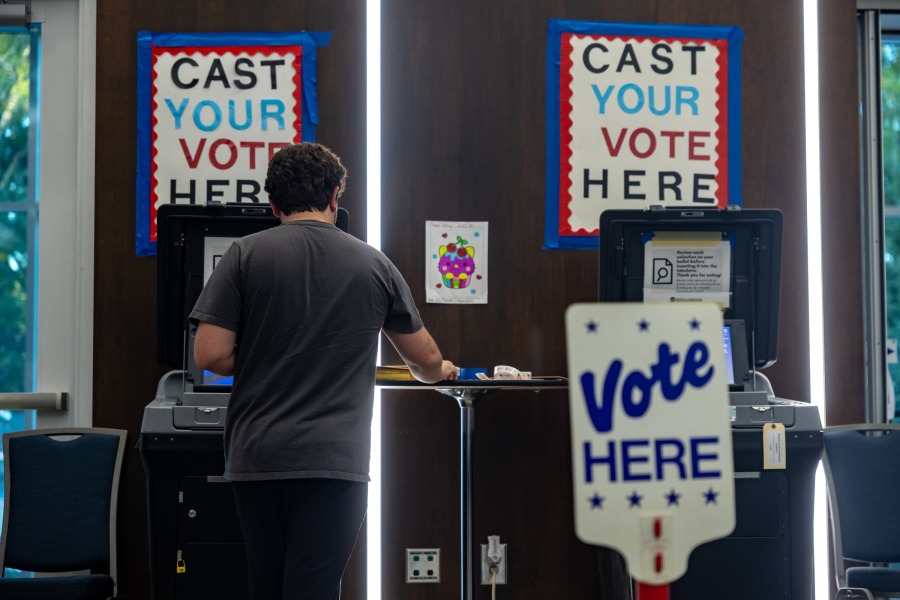
Early voting numbers are showing a high number of Republicans casting their ballots ahead of Election Day, but that doesn’t mean an automatic victory for former President Donald Trump and Republicans down the ballot.
Historically, Democrats have been more likely to vote early in states where that’s an option, but with just a week before the election, they’re just barely ahead of Republican early votes nationally.
A partisan split in early voting was especially noticeable in the 2020 election, when Democrats were more hesitant to gather in public than Republicans due to the Covid-19 pandemic, and many states expanded early voting options. Trump routinely criticized early voting in 2020, which exacerbated that imbalance. Now, the pandemic is over, and Trump has undergone a shift: While he sometimes still disparages the practice of early voting by mail, he has also actively encouraged his followers to vote early.
That encouragement now appears to be paying dividends: According to NBC’s count, 44,101,704 early votes have been cast by mail or in person, out of more than 160 million registered voters. The 2016 election saw a final total of 57.2 million early votes, according to the Election Assistance Commission, out of more than 135 million voters. Since the 2020 election, there does seem to be an increasing trend toward early voting.
Most states offer early voting either by mail or in person. Alabama and Mississippi are exceptions, though they offer absentee voting. (Kentucky and Missouri offer limited early voting options.) With early ballots coming into so many states — each with their own voting rules and time frames — early voting data can shift quickly. And that means we can only learn so much from it.
Related:
- The massive gender gap in the election, in 2 charts
- If Harris loses, expect Democrats to move right
- Elon Musk is Trump’s biggest booster — and patron. Why?
What early voting data can — and can’t — tell us
At this point in the early voting period, just about the only thing early voting data tells us for sure is who’s voting early.
“Among everyone who’s voted so far — not all of them, but by and large, they’re your super voters,” Michael McDonald, who runs the University of Florida Election Lab, told Vox. “They’ve made up their mind who they’re going to vote for, that’s who casts their ballot first.”
Usually, McDonald noted, those “super voters” tend to be Democrats. They also tend to be registered with a particular party and to be older voters. Women have historically been more likely to vote early; that trend is holding in the data available so far, McDonald said. The difference is, a greater proportion of those early women voters are Republicans.
And a larger number of Republicans voting early this year may not have any bearing on who ends up winning the election.
“I’m very cautious about interpreting early voting,” John Fortier, a senior fellow at the American Enterprise Institute, told Vox. “We’ve had change in trends in early voting, and different types of early voting — and then, of course, a very strange election [in] 2020. The basic trend, looking at the ’90s, 2000s, and up to the 2016 election is we just had a slow increase each election in the percentage of people who would vote by mail and also the number of people who would vote early in person.”
There do tend to be turnout trends in early voting, Fortier said, which he predicts will hold this cycle. “You often see a very big bump the first three or so days of the early voting period, especially if it’s a longer voting period. And then you see somewhat lower [turnout], and then there’s a big, big push in the last five, six days, as we are ramping up to Election Day.”
But both the 2020 election and Trump’s push to have his followers vote early have changed dynamics such that it’s hard to apply historical trends to early voting in 2024.
Mail-in ballots, which are the default option in some Western states like Colorado, Oregon, and Washington, represent another wrinkle entirely: The data lags behind in-person early voting information. And Democrats tend to be much more inclined to vote by mail, McDonald said.
Plus, logistical issues, such as the dates that mail-in ballots are sent out, can skew data further, as has happened in Clark County, Nevada. Early vote turnout appeared shockingly low for this point in the election — until it was discovered that ballots had been sent out later than in previous years and therefore would be returned and counted later in the early voting period.
“We see lots of Republicans voting in person early, but we know there’s going to be lots and lots of mail ballots,” especially in Western states like Washington and Oregon, where in-person voting is very limited,” McDonald said. “And we know that the Democrats are preferring to vote by that method, and we’ll start seeing those showing up later. And so it causes these imbalances to appear.”
Ultimately, Fortier said, we’ll likely see the highest turnout on Election Day itself, though overall this election might signal a shift to more early voting. Experts might be able to accurately predict which way certain states will go by their early voting numbers as early as this weekend, but that’s likely to be the exception to the rule.
Related:
- A new Supreme Court case could change the result of the presidential election
Source: vox.com